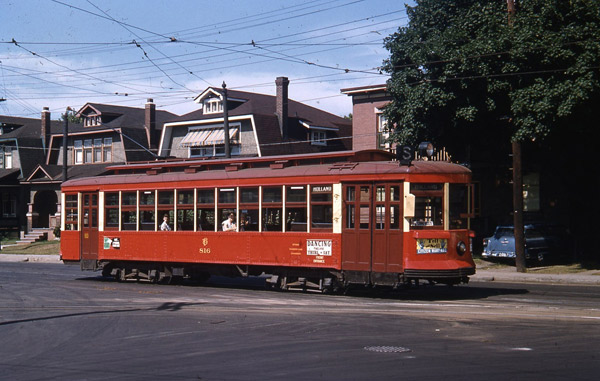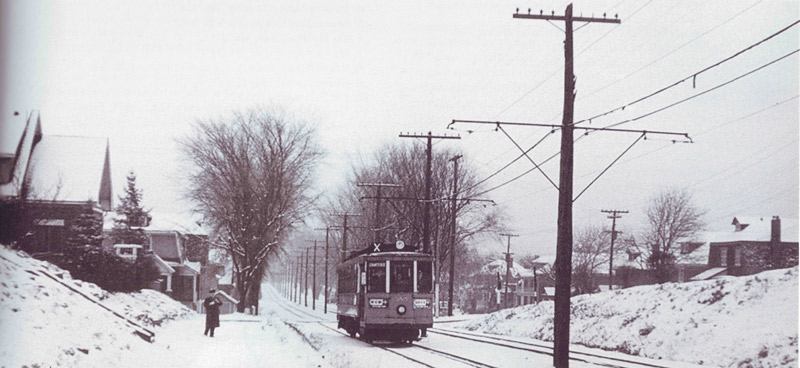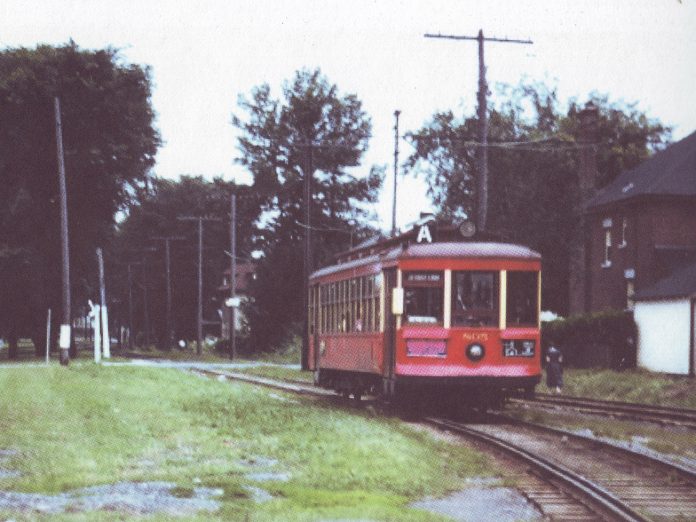To present-day residents of Kitchissippi, Byron Linear Park is a much-appreciated strip of greenspace approximately three kilometres in length where we walk, run or cycle, shop at a farmer’s market, or play at the “School Bus Park” near Mayfair Avenue.
However, for previous generations, this parkland had a different purpose. For fifty-nine years this was the location of the streetcar. It represented more than just simply a method of transportation. The streetcar opened up Ottawa to the west, making both the city and the suburbs more accessible. Almost overnight it turned vacant farmland into valuable real estate.

Horse-drawn passenger cars on rails began operating in Ottawa in 1870, but it was the magic of electricity which was amazing the world by 1891, and on June 30, 1891, “thousands lined Bank Street to view the strange sight of cars that ran without being pulled or pushed” when the first streetcars ran down Bank Street from Albert to Lansdowne Park.
The Ottawa Electric Railway (OER) was incorporated in 1893, and Hintonburg, then still a part of Nepean Township, desperately wished for the streetcars to pass through the growing village. Nepean Township was hotly opposed to allowing Wellington Street to be taken over by electric railcars. Hintonburg’s population of 750 felt so strongly about the issue that they decided to separate from Nepean in 1893 to become an independent municipality.
Hintonburg Council struck their deal with the OER (who wanted their line to access the Experimental Farm) in July of 1895, and track construction began immediately. The first streetcar arrived in Hintonburg on October 3, 1895. The official opening of the completed line was on April 30, 1896, with trolley wires strung from a single line of poles between the tracks, with an arm extended on each side. The cars “passed through some nice residential country,” as the newspaper described the area around Holland at the time.
To coincide with this feat, the owners of the OER, who also had a stake in the Ottawa Land Association (which had recently purchased the Hinton, Holland and Stewart farms) constructed what was then Ottawa’s largest amusement park, the West End Park on the land between what is now Harmer and Hinton, south of the Queensway. The park had a popular, but very brief existence.
In 1898, the OER began to plan for the construction of an amusement park at Britannia, accessed by a streetcar line. Approval was obtained in June 1899, and the first shovel was in the ground on September 8. The starting point for this line was selected at a random point on Holland Avenue, 500 feet south of Wellington Street, to give it as straight a run as possible to Britannia. Byron Avenue did not yet exist.
Three hundred men and 50 teams of horses were employed in building this extension. Grading was a problem in some areas, particularly east of what is now Island Park Drive, and west of Churchill where an excavation of 19 feet was made. This rock was later used to form the famous 1,000-foot pier at Britannia. Trolley poles were constructed in the centre of the line, supporting iron brackets which held the trolley wires in position. Poles and fences were all painted white to add to the aesthetics of the line.
Regular service was introduced on May 24 1900, and immediately created a popular resort at Britannia, which featured the area’s first public swimming area as well as concert pavillions, picnic areas, boat houses and dance hall. It was known as the “People’s Playground.” The Britannia Line was a success, and Ottawans happily paid the five cent fare to escape the city.
Summer resort hamlets instantly opened up all along the line. Many neighbourhoods – including Hampton Park, Wellington Village, Champlain Park, Westboro and McKellar – have the streetcar line to thank for their development.

The five cent fare remained for many years. Special fares were established for working men, school children and Sunday riders until 1920 when, after a two-year battle that went all the way to the Supreme Court of Canada, the OER doubled fares for those taking streetcars west from Holland Junction. As a result, many residents (including distant Nepean High School students) took to walking long distances to and from Holland to save half the fare.
In the late 1940s, the trend in transportation planning was to eliminate rail lines in favour of more highways, freeways and roadways. Buses replaced the streetcars, and cars became king.
The death sentence of the streetcar was handed down in 1948 when it was determined that the OER (then carrying more than 50 million passengers annually on their streetcars and limited buses) should be municipally operated. The City of Ottawa paid $6,000,000 for their assets and created the Ottawa Transportation Commission. Two years later, Ottawa annexed much of Nepean, increasing Ottawa’s size from 5,000 acres to 27,000 acres. This forced the OTC to service an area five times as large, much of it sparsely populated. Passenger volume fell drastically. The OTC was operating at an annual loss and ultimately had to replace streetcars with buses.
1956 saw the removal of the line south down Holland to Carling, and three years later, on May 1, 1959, the final train ran to Britannia on Ottawa’s last streetcar line. The next day a large ceremonial parade was held to mark the end of streetcar service. 25,000 people turned out to see a procession of historic streetcars travel from downtown to its end point at Holland and Byron. Within a year, the streetcar tracks were dismantled.
Though the streetcars have been gone for decades they live on in the form of an occasional railway spike found in the garden of a Byron Avenue resident, or the odd pole or wire that still stands; but moreso, they live on in the memories of those who still recall the thrill of riding a streetcar through the neighbourhood, an experience that many of us can only dream about.
Dave Allston is a local history buff who researches and writes house histories and publishes a blog called The Kitchissippi Museum. His family has lived in Kitchissippi for six generations. Do you have early memories of the streetcar? We’d love to hear them! You can contact us using this form. Thank you!
